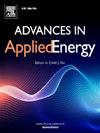A newly developed spatially resolved modelling framework for hydrogen valleys: Methodology and functionality
IF 13.8
Q1 ENERGY & FUELS
引用次数: 0
Abstract
Regional initiatives, like the European hydrogen valleys, aim to solve the simultaneous absence of green hydrogen production, infrastructure, and application with coordinated development of the whole supply chain. A new model framework was developed to bridge the gap between linearised energy system models and detailed plant simulations that allows for dynamic, nonlinear simulation and optimisation of regional hydrogen systems from electricity generation to hydrogen application. The model incorporates different supply algorithms for electricity and hydrogen, representing both bilateral contracts and flexible markets. A case study demonstrates the application of the framework within a representative hydrogen valley in Germany, showing how the model can identify optimal configurations of hydrogen production, storage, and distribution infrastructure to minimise the levelized cost of hydrogen. The influence of different spatial resolutions, exchange control algorithms, and boundary conditions chain are evaluated. A too coarse spatial resolution can underestimate system cost by up to 10 % while the allowance of both bilateral hydrogen contracts and a flexible market algorithm can increase hydrogen utilisation and reduce cost by up to 15 %. An autarkic supply of hydrogen demands was possible for 7.60 €/kg, while the option to use grid electricity reduces costs to 6.37 €/kg and the option to import hydrogen to 6.60 €/kg, based on the assumptions for electricity and hydrogen prices. This work contributes to the evolving field of hydrogen economy by providing a sophisticated tool for policymakers and industry stakeholders worldwide to plan and optimise regional hydrogen valleys effectively.
新开发的氢谷空间解析建模框架:方法和功能
区域倡议,如欧洲氢谷,旨在通过整个供应链的协调发展,解决绿色氢生产、基础设施和应用同时缺乏的问题。开发了一个新的模型框架,以弥合线性能源系统模型和详细的工厂模拟之间的差距,允许从发电到氢应用的区域氢系统的动态、非线性模拟和优化。该模型结合了电力和氢气的不同供应算法,代表了双边合同和灵活的市场。一个案例研究展示了该框架在德国一个具有代表性的氢谷中的应用,展示了该模型如何确定氢生产、储存和分配基础设施的最佳配置,以最大限度地降低氢的平均成本。评估了不同空间分辨率、交换控制算法和边界条件链的影响。过于粗糙的空间分辨率可能会低估高达10%的系统成本,而双边氢合同和灵活的市场算法可以提高氢的利用率并降低高达15%的成本。根据电力和氢气价格的假设,自给自足的氢气需求供应可能为7.60欧元/公斤,而使用电网电力的选择将成本降低至6.37欧元/公斤,进口氢气的选择将成本降低至6.60欧元/公斤。这项工作通过为全球政策制定者和行业利益相关者提供有效规划和优化区域氢谷的复杂工具,为不断发展的氢经济领域做出了贡献。
本文章由计算机程序翻译,如有差异,请以英文原文为准。
求助全文
约1分钟内获得全文
求助全文

 求助内容:
求助内容: 应助结果提醒方式:
应助结果提醒方式:


